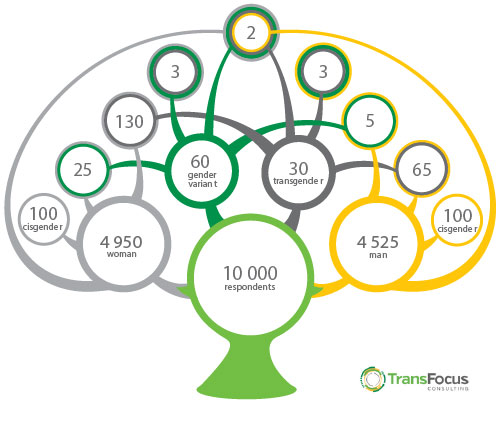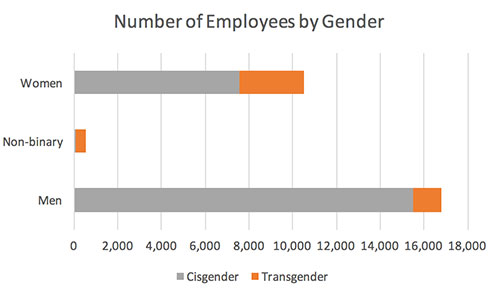Three Pitfalls for Expanding Gender Demographics on Employee Engagement Surveys
By Kai Scott
Recent societal and legal shifts have brought transgender issues to the forefront for companies in their diversity and inclusion efforts. One issue that has surfaced as an important one is the the gender demographic question on employee engagement surveys with only two responses of “female” and “male.”
This foundational statistic is especially critical for companies to get right given the emerging trend and role of big data, including its applications within human resources. We want our dashboards to reflect what is actually happening on the ground to inform meaningful and effective decision-making and direction for our companies—including complete and accurate gender data.
The Trouble with Limited Options
There are two key problems associated with limited response options for the gender questions: 1) they undermine data integrity, and 2) they perpetuate institutional invisibility.
Often, data on transgender people is considered a separate, stand-alone matter. However, they are inextricably linked to data on cisgender people1 in that female and male categories are currently an unknown blend of cisgender and transgender employees. This points to the need for collecting gender data in such a way that it allows flexible combination and separation of cisgender and transgender data in order to support employee wellbeing and drive business outcomes. Without this data integrity, the very basis of engagement survey data is on shaky ground.
The second issue is that non-binary2 employees are unaccounted for in most existing employee engagement surveys. With only two response options, non-binary employees are forced to choose categories that are antithetical to their identity or opt out of providing their gender. Employers unintentionally signal “you don’t matter” because some employees’ core identity is not listed as a response option. This is based on the deeply ingrained assumption that there are only two genders (i.e., men and women).
Furthermore, companies often conclude that there are no issues in the absence of this important data. However, we know from transgender-specific studies that non-binary people face grave challenges (James et al 2016). Companies want to do better by collecting data on their non-binary employees as one way to know their unique needs and more fully support them.
Exploring Three Common Pitfalls
At TransFocus, we know first-hand through our work with various organizations across diverse sectors that there is not a one size fits all solution to these problems. It is not as simple as adding a third checkbox. Here are three common pitfalls that companies encounter in hasty efforts to expand gender categorization that complicate responding to gender for everyone.
First, many companies opt to add the response category of “other,” which at first glance appears to be the most expansive third option. However, many transgender and non-binary people experience this option as problematic and literally “othering.” Also, the data collected in the “other” category does not yield to companies any useful or meaningful data that can be applied to decision-making, because it lacks any specificity.
The second most common misstep is the added response category of “transgender,” which may similarly appear to solve the problem. However, this presents a dilemma for transgender women and men, who are forced to choose between their trans experiences and identifying as the men or women that we are. Much like the limitation of only M/F response options, this pitfall leads to continued invisibility within organizational data.
Another common proposal introduces a range of gender categories with “select-all-that-apply” functionality. Optically, this approach appears to be inclusive of a diversity of gender identities; however, functionally it misses the park. That is, the “select-all-that-apply” function actually multiplies the number of categories, which can complicate and confuse data collection and analyses. For example, how do we interpret someone who selects all the categories? Further, respondents can scatter across a multitude of categories with low response rates in some categories (as illustrated in the visual). This results in data suppression to maintain confidentiality with an accompanying loss of focused and inclusive analyses to inform effective organizational decision-making.

Strategically Tailored Solutions
Instead of getting mired in these (and other) pitfalls, companies are better off undertaking a deliberative and rigorous process to explore the rationale, collection, flow, and application of gender data as a way to identify the solution that is right for both the organization and their employees. This process takes into account the number of employees, privacy and confidentiality requirements, decision-making needs, and data interdependencies within various areas of the organization.
It allows companies to identify the issues at play and clarify the objectives among several internal and external stakeholders. This entails strategic sorting and prioritizing of key trade-offs to arrive at tailored solutions to drive employee engagement and business outcomes. In turn, this process yields sustainable data solutions with flexible outputs (as illustrated in the bar graph) to inform business directions for years to come.

Kai Scott and Drew Dennis are presenting the Are You Ready to Support Transgender Employees? webinar on March 13. For more information on this and other professional development opportunities, please visit cphrbc.ca.
Kai Scott, M.A. is the principal of TransFocus Consulting, a firm that blends both lived trans experience and technical expertise to free human potential from gender assumptions.
1. People whose gender identity aligns with their sex assigned at birth.
2. An umbrella term for people who do not identify as women or men. This includes those who identify somewhere between or completely outside of these two genders.
Additional References:
James, S. E., Herman, J. L., Rankin, S., Keisling, M., Mottet, L., & Ana, M. (2016). The Report of the 2015 U.S. Transgender Survey. Washington, DC: National Center for Transgender Equality. Accessed February 2018







